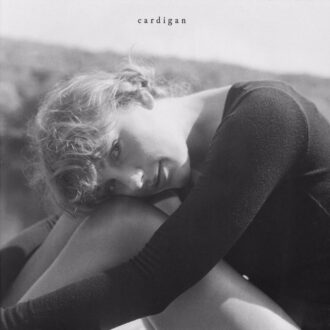A Weekend At Subterranean Dissonance, Philadelphia’s Celebration Of Heavy Experimentalism
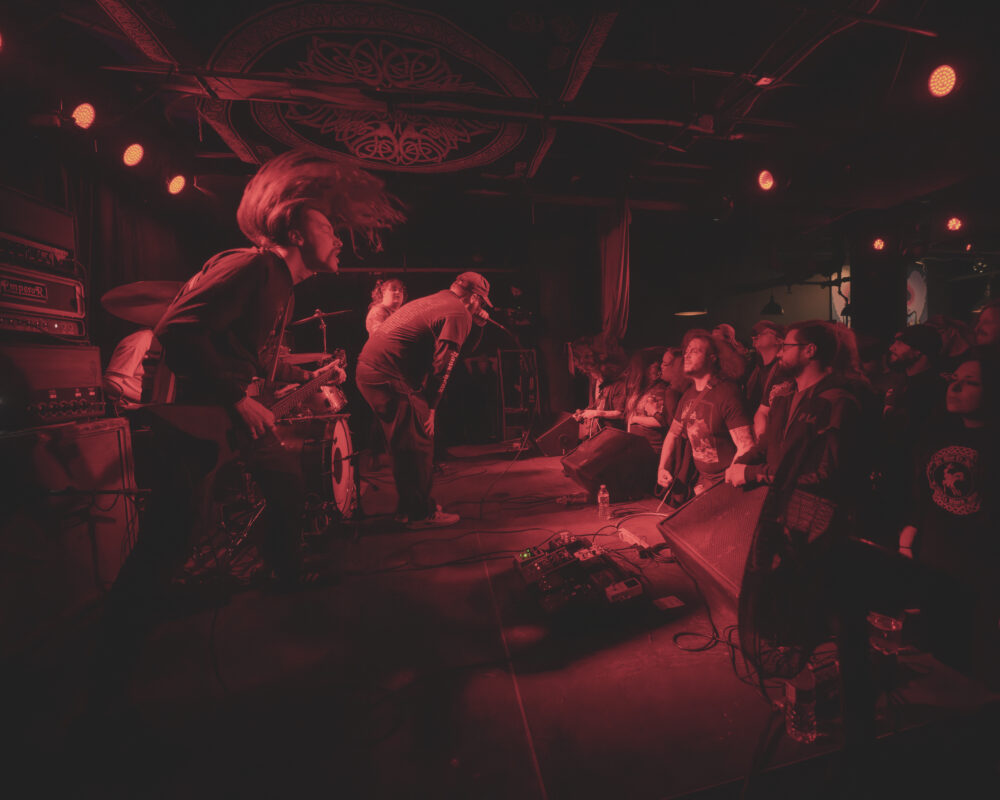
Keith Baker
“I’m known for one thing. I’ve only done one thing,” explains Sean Ingram, the vocalist behind pioneering mathcore outfit Coalesce. “I was ready for the past to be the past and to do something new, without fear.”
Two hours later, Ingram and producer Josh Barber commence the live debut of their new post metal band, Idle Heirs, in front of hundreds of heavy music connoisseurs attending the third annual Subterranean Dissonance festival. The first two-and-a-half minutes of Idle Heirs’ set features Ingram’s clean singing over gentle, folksy guitar — decidedly unlike Coalesce. Seven people total occupy the stage — two holding guitars, one a bass, one behind a drum kit, and two more switching between a bevy of electronics: keys, samples, electronic drums, a theremin. Ingram darts between trademark hollers and gentle passages while Barber and the remaining instrumentalists wade between melody and atmosphere, unchained by specificity. It’s an emotionally charged, stylistically agnostic take on heavy music that has the audience questioning whether it’s time to mosh or weep.
This is what Subterranean Dissonance is all about. Since 2023, the fledgling Philadelphia festival has celebrated the experimentalists of heavy music, predominantly from the metal and hardcore worlds. Over two nights, Feb. 7 and 8, 16 acts ranging from cybergrind to mathcore to black metal alternate between the two rooms at Underground Arts. Subterranean Dissonance is part of a larger ecosystem of events with a similar aesthetic orientation, like RVA’s Dark Days Bright Nights or Copenhagen’s A Colossal Weekend. The massive Dutch festival Roadburn is the crown jewel of the alternative heavy circuit, featuring special sets, artist curation, commissioned projects, and artist panels.
At a time when metal’s stadium class feels more detached from the underground than ever, the alternative/experimental heavy underground seems to be growing gradually more influential, even amid skepticism about the veracity of “hipster metal” that has stretched out for going on two decades. It’s inviting people in and keeping them engaged with heavy bands making experimental music and introducing them to the canons of death metal, black metal, and more of the styles that inspired their oddball projects.
Obviously, “hipster metal” isn’t a unified style. But, for as long as there’s been heavy music, there have been experimentalists who break seemingly essential rules of metal, stoking controversy. In the Bush era, the emergence, and critical celebration, of bands like the Sword, Mastodon, and Wolves In The Throne Room helped foment a conflict between metal lifers and this new guard. It’s a battle that mostly feels silly, but the metal underground at present feels fractured between the critic-pleasers, the subgenre purists, and the exploding deathcore revival seen not only in the music of Torture, PeelingFlesh, or Vomit Forth, but also how those acts tour and carry themselves.
Bands like Agriculture know where they fit in as yet another band flouting black metal orthodoxy. “What does it mean to be authentic in metal?” asks Dan Meyer, the group’s guitarist and vocalist. “In this old-fashioned way, metal’s interested in authenticity in a way that most genres are not. But none of us are vampires or murderers.” Agriculture’s approach to black metal could hardly be called “true kvlt,” but their explosive, thrilling take on the genre — which they call “ecstatic black metal” both sincerely and in jest — inspired extensive enthusiasm from veteran and novice fans alike on the festival’s second night. To dismiss their music as mere “hipster shit” risks missing out on one of the broader metal scene’s most fun new bands.
What’s made events like Subterranean Dissonance, and the whole experimental wing of heavy music, more popular is the growing profile of musicians who work across any number of genres while retaining some stake in the concept of heaviness. “I ran into George from Deafheaven at an Emma Ruth Rundle show,” Meyer explains, “and we were both like, ‘Why is this so metal?’ She’s singing these beautiful songs but it’s just so heavy.” Rundle’s folk-adjacent post-rock singer-songwriter albums can serve as a bridge to this in-between region of heavy music: Indie kids find their way into Rundle’s music and realize how raw it can feel to pair her voice with Thou’s extremity on May Our Chambers Be Full. The reverse happens with heavy music fans: “Just look at Emma Ruth Rundle. I would’ve never listened to her until May Our Chambers Be Full when I realized how tight and heavy her music is,” says Barber.
Whether this “hipster” music is legitimate or not, alternative/progressive heavy music is an increasingly popular way for music obsessives to dip their toe into metal and hardcore scenes that can be awfully self-referential. In a globalized scenes where bands are encouraged to rip each other off and maintain traditions that look back to the explosions of thrash, death, and black metal from the mid-’80s to the mid-’90s, it can feel daunting to try and differentiate the latest death metal bands from each other when their albums are all subtle subversions of totemic works. Experimental heavy music weaponizes tools from outside of heavy music, like contemporary classical, jazz, folk — anything, really — to augment the underlying metal techniques. For scene newcomers, these atypical components are a compelling hook that draws listeners in and introduces them to metal techniques: blast beats, shrieks and growls, downtuning, tremolo picking, you name it.
In conversation with several of these bands, it’s clear that their avenues into extreme music vary. For Scarcity’s Brendon Randall-Myers, training as a composer primarily in post-punk and contemporary classical spaces leant itself well to becoming acquainted with NYC’s avant-metal scene. For Agriculture guitarist Richard Chowenhill, growing up in the East Bay meant exposure to the gnarly world of thrash, exposing the emotive possibilities offered in metal. Agriculture bassist/vocalist Leah Levinson came up in the messy hardcore underground, so metal proved difficult for her at first: “Metal didn’t click when I heard the big names who were super pristine and proficient in a way I found not challenging. I was like, ‘Why are they so locked in?'” Experimentalists like Kayo Dot and Portal were the bands that drew her in.
On one end, you have the heavy singer-songwriters like Midwife, Emma Ruth Rundle, or Richard Dawson, whose approaches cultivate dark atmospheres that gesture at the same weighty resonance that makes doom metal so appealing. Even Ethel Cain falls in this paradigm: There’s post-doom all over Preacher’s Daughter, like in the molasses drumbeats of “A House In Nebraska” or the sludgey climax of “Ptolemaea.” Now, with Perverts, maybe alt pop fans will gather the courage to check out Prurient. On the other end, you have the unrelenting extremity of Portal, Merzbow, and Sunn O))), who never should have been crossover acts, but they have this unforgiving extremity that offers no wiggle room. It doesn’t hurt to know the history of doom when listening to Sunn O))), but at a certain level, their take on drone metal is so singular and hypnotic that no one can look away from it. Increasingly, the internal mechanisms that kept these micro-scenes separated are disintegrating: “I see kids with Korn shirts who also own Blood Incantation shirts. They’re also fans of Ethel Cain,” recalls Barber. “Now, how can we be a bridge to post-metal for the people in our scenes?”
On the first night, Atlanta four-piece Malevich open with a dizzying spread of hardcore-inflected blackened sludge. There are flashes of death there, doom here, post-hardcore there, yet none of it feels rushed or disjointed; every technique switch that unveils a new aesthetic palette is accompanied by a commensurate vocal and lyrical shift. Following in the next room is Underer, the one-man industrial/doom explosion of Nick Shellenberger from Cleric, perhaps the most decorated band in Philadelphia’s metal avant garde. In between unpredictable shrieks, Shellenberger takes a minute to address the audience: “I was really close to canceling this set. I’m glad I didn’t.” With the constant stream of distressing news out of Washington, the unrelenting emotionality in each Subterranean Dissonance set hits with a special potency.
Scarcity are next. The Brooklyn black metal band is slowly becoming a personal favorite of the heads, who’ve come to admire the clash between Doug Moore’s signature howls and Brendan Randall-Myers’ precision guitar work. Randall-Myers is a composer and multi-instrumentalist by trade, performing with the Glenn Branca Ensemble and guitar quartet Dither, who came to metal composition to process extreme emotion after admiring his buddy Moore’s fellow Subterranean Dissonance band Pyrrhon. Scarcity open their set with “In The Basin Of Alkaline Grief,” an extremely disorienting six-minute assault of competing tunings and polyrhythms that Randall-Myers calls “car alarm music.” “I had to move around the stage so I could hear the quarter note from the cymbal,” Randall-Myers later tells me. They start with selections from their most recent album, The Promise Of Rain, and close with part-mathy, part-atmospheric cuts from their debut, Aveilut. After Scarcity is the aforementioned debut set from Idle Heirs, kicking off the live promotion for their first effort as a post-metal band, April’s Life Is Violence.
Next are Krallice, whose expansive take on black metal reignited interest in the traditions of Gorgoroth and related innovators while pushing the subgenre to its most progressive possibilities. By this point, the room is so packed that I spend most of the set sandwiched between the merch tables and coat check, peering between a wall and a pillar to watch a sea of heads gaze starstruck at the legends who dared to blacken prog metal. From where I’m standing, the members of Krallice look more like wizards than mortals. As they wrap up, I try for a good viewing spot for Young Widows, who I expect to serve as a palette cleanser, owing to their clean vocals. The singing notwithstanding, the band is deceptively heavy: in the more than 10 years since Easy Pain, Young Widows’ sound has gotten chuggier and fuller, with each groove slamming through your chest like a sledgehammer. The metallic edge coating each post-punk track is subtle on record but oh, so destructive live.
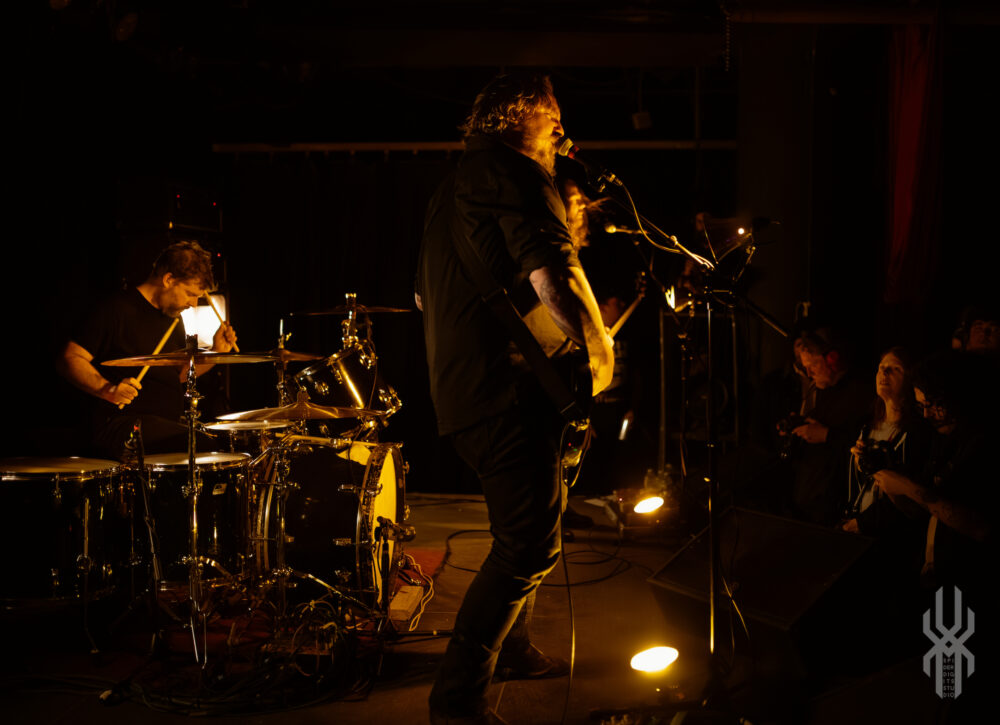
Robert Shelley
Tonight’s headliners are Thou, the Louisiana sludge freaks whose latest album Umbilical is a triumphant standout among a broad discography of triumphant standouts. Vocalist Bryan Funck’s energy contrasts with most of the preceding acts who maintain a kind of ominous detachment: His eyes remain peeled back as if possessed while lunging at the audience and his bandmates, all of whom match his punkish swagger as best they can. The audience eats it up, thrashing their arms and throwing their bodies up against each other while guitars chug and, slowly, coalesce into fuzzy melodies. Umbilical feels like the exact right album for this crowd: steeped in the hardcore punk that remains central to Thou, but performed with an especially coarse coat of sludge, giving the diehard metalheads more than enough red meat on which to gnaw.
Thou are perfect headliners for an event like this. While the music they’ve been releasing has a metallic feel, they maintain little to no connection to metal. “We’re not that interested in metal. We all come from punk and hardcore,” Bryan Funck clarifies while perusing the selection at an alternative comic shop. “We’re friends with people in metal, but it’s funny when people think we have any influence in the metal scene. It’s not like we’re thinking about the metal of it; we’re interested in bumping elbows with the people who make the music we like. It might be Hell or Mizmor, or it might be Silver Godling or Emma Ruth Rundle. That’s just who’s doing interesting stuff with music.” Thou’s lineup is full of punks who are drawn to musicians whose take on heavy, dark music is singular. Their collaborative albums are totemic: Myopia, their 2022 collaboration with solo blackened doom experimentalist Mizmor, is a gruesome mix of devastation and beauty. May Our Chambers Be Full, released with Emma Ruth Rundle, provides that on-ramp for heavy music fans into more openly beautiful territory and for heavy music skeptics to realize they have a way in. It’s no accident that both collaborations count Roadburn as a key part of their histories.
Umbilical refocuses Thou’s microscope back on themselves: Twenty years of being a band has meant making a slew of compromises in service of longevity. “In my experience, you have to make certain concessions with each other to make things worth it,” Funck explains. That doesn’t leave much room for idealism. Much of Umbilical comes from the perspective of younger Thou hollering at older Thou for selling out: They’re staying in a hotel after the show, after all. Funck has plenty to be mad at his younger self about: “[I was] a fuckin’ loudmouth prick. People think I’m hard to deal with now; they should’ve met me 20 years ago.”
The writing process for Umbilical turned out pretty long for a project they initially promised to keep to one LP, but the end product is an especially jarring, kinetic Thou that annihilates punk lifers and sludge fiends with unchecked aggression. That said, even with these more brazen breakdowns and jagged riffs, audiences still tend to stand and stare: “I’m not a performer. I’m not a frontman. To get out of my head, I need other people to have a good time to help me have a good time.” Even though the crowd at Subterranean Dissonance has been on their feet for hours prior, their response to Umbilical material is the most lively of the night, with a select few brave souls unleashing their bodies in sync with the music. Those who are less drawn to moshing are at least banging their heads with an enthusiasm typically reserved for Obituary sets.
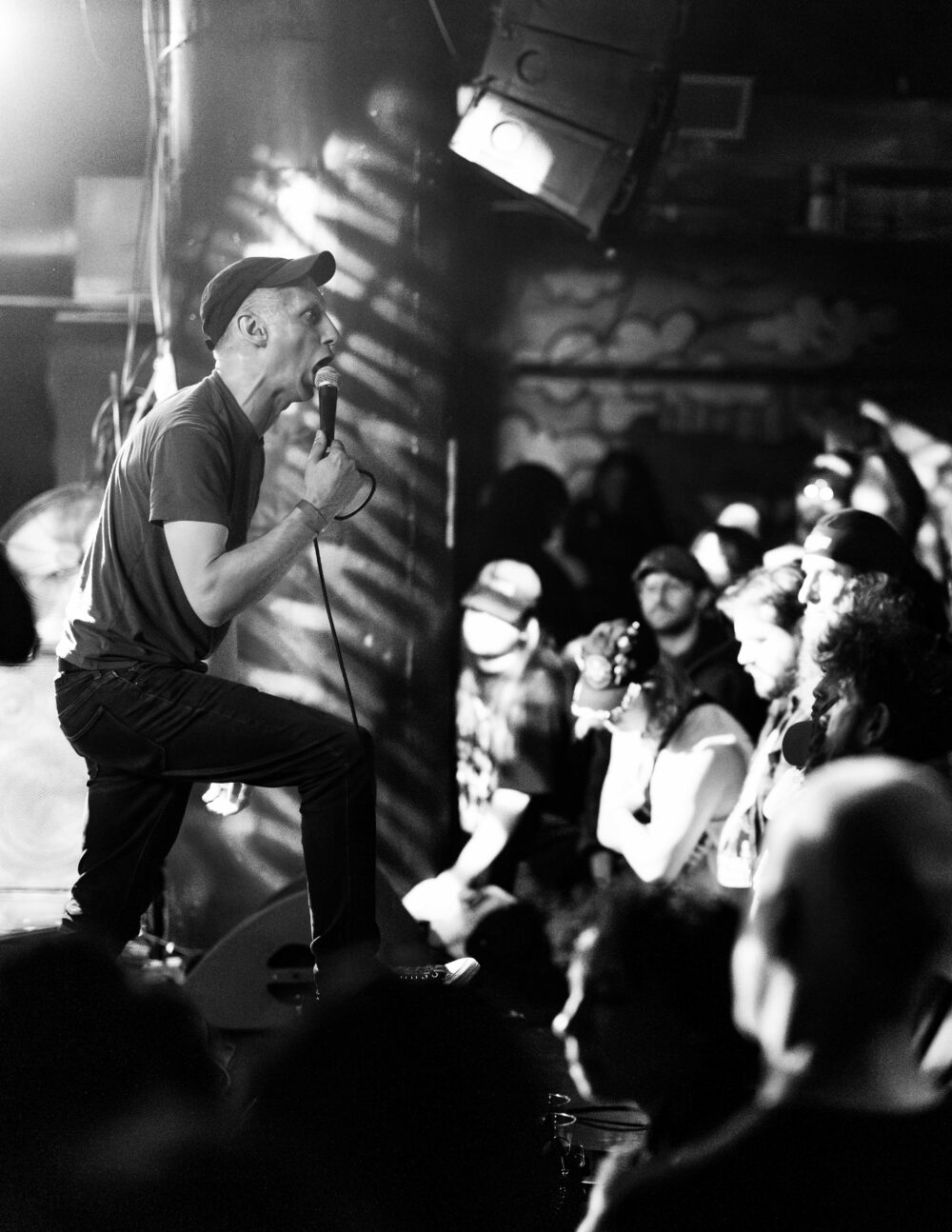
A.J. Kinney
The next night, Philadelphia’s own ZOMBIESHARK! opens with a solo cybergrind set that swings between vulnerable and downright nuclear with no warning, delivering perhaps the most visceral set of the whole festival. The vibe shift immediately thereafter with the metallic jazz of the Hollenberg, Weston, Spiker trio is similarly jarring, but their exploratory improvisations got raucous applause from a massive, curious audience.
Shortly before the festival, the “secret set” was revealed to be Chained To The Bottom Of The Ocean, the rising New England death-sludge quartet who carry themselves more like a hardcore band, dousing the room with a nuclear energy that’s impossible to wash away. Following them are the Silver, the supergroup of Horrendous and Crypt Sermon members who rely less on perpetual terror and meditate on the human experience with due touches of harshness. There are blast beats, sure, but they also traffic in romance, made most evident through their extensive use of rose imagery. To date, the Silver are the only band I’ve seen work with black metal and space rock in the same breath. Dysrhythmia soon follow, offering another foray into jazz-informed, highly technical instrumental metal, dialing back the explosive potential of experimental metal while engaging in a kind of evil hypnosis. The heads are especially stoked for Dysrhythmia’s set, which offers the chance to see some of the most prolific instrumentalists and producers within this heavy experimental scene in their rarest form. They don’t disappoint.
Dysrhythmia’s haunting quietude leaves plenty of room for Pyrrhon to perform their 2024 album, Exhaust, with the most pyrotechnic energy possible. Depending on how you square things, Pyrrhon is the sole representative from death metal of the weekend, but even their take is esoteric, highly technical, and somewhat low on gutturals. For a band performing songs all about spiritual and machinic degradation, Pyrrhon do not miss an opportunity to rile up the audience with maximalist screams or extremely tight runs. Agriculture follow them up with a similarly confrontational set, but their black metal stylings substitute complexity for beauty and harness the natural exhilaration of metal performance toward irresistible catharsis. As the band barrels through fan favorites like “Relier” and “Living Is Easy,” listeners around me raise their hands as if reaching for God himself, as if to invite Him into the pit, as well.
Up next are Deadguy, the legends behind Fixation On A Co-Worker, the 1995 album that serves as a vital inflection point for mathcore as its own movement following metalcore’s initial rise. Having reunited a few years ago, Deadguy are tight and jovial, ripping straight edge jokes (“I’m straight edge, so I can say it”), continuously breathing new life into old favorites while opening up the most forceful pit of the weekend thus far. After an hour of controlled chaos, they vacate the stage for Secret Chiefs 3, perhaps the perfect closer for the weekend: Heavy but only partially metallic, SC3 are experimental, transnational, and theatrical. Bandleader Trey Spruance is a chameleonic figure, welding Middle Eastern experimental exercises with prog rock and the mere suggestion of metal. If the bulk of Subterranean Dissonance’s performers are perennially at risk of being called “hipster metal,” SC3 are simply too weird for even that label. In a weekend of unbridled experimentation, SC3 are perhaps the least inhibited.
Weekends like these — where fans of metal’s experimental fringes come together to take stock of where the scene’s been and where it’s going — are becoming more frequent around the globe as more and more mini-festivals like Subterranean Dissonance take hold. As disjointed as the heavy music underground is, the experimental side has gradually grown more and more prominent, maintaining a hold on critics and inspiring more artists to dabble with tools typically associated with metal or hardcore. The scene is getting more attention from heavy music lifers and new entrees alike: Among the hundreds of attendees of Subterranean Dissonance, no one age group stands out most prominently; it feels as if there are equal parts Gen Z, millennial, and Gen X all around me. Most importantly, everyone really cares.
“I had lots of conversations with people after the set,” Randall-Myers says. “People really care about this music. People make and listen to this because it resonates with them on a deep enough level. You can tell that this is a big part of who people are.” Even if the current crop of dedicated enthusiasts isn’t at a critical mass to push their favorites into the stadium class, it’s clear that there’s more than enough momentum and commitment here to ensure that heavy experimentalism will steadily keep growing.
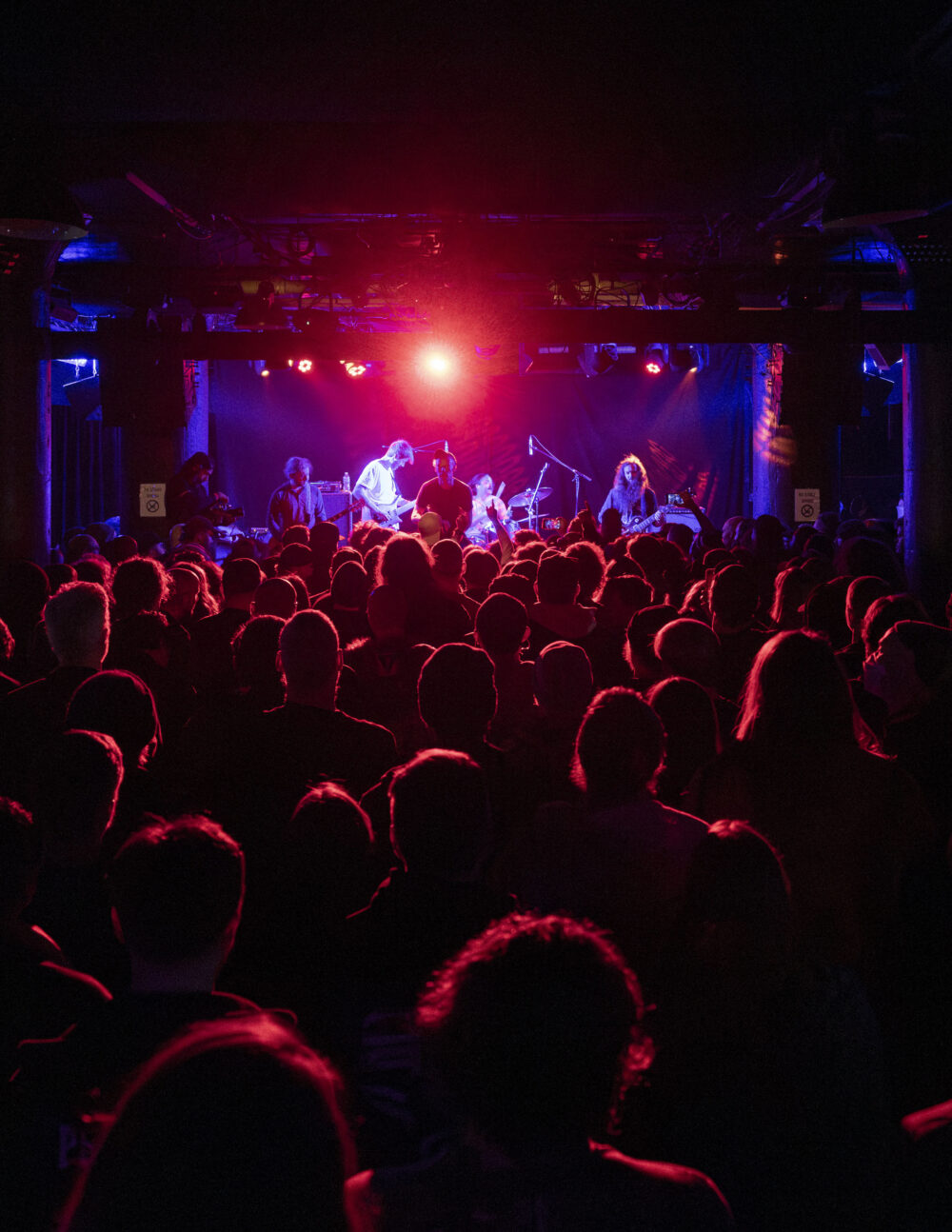
A.J. Kinney



